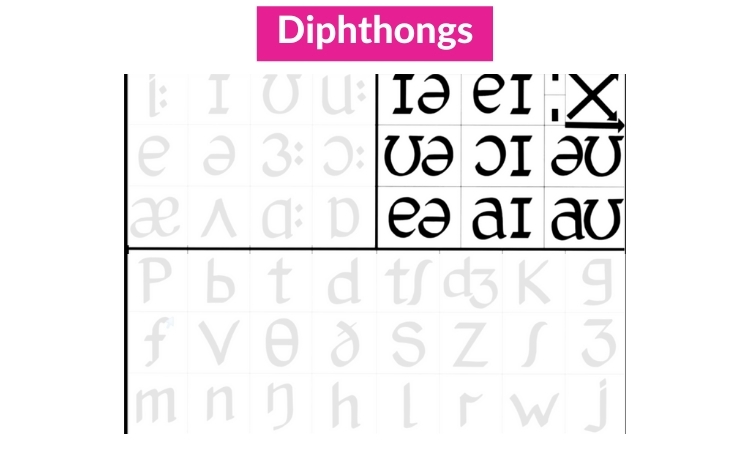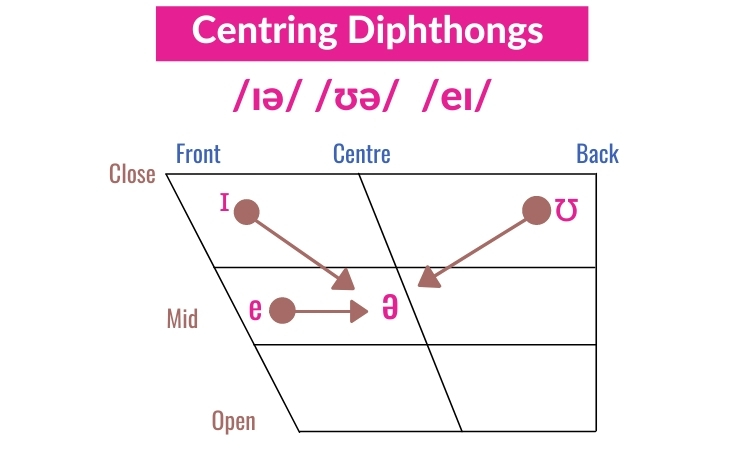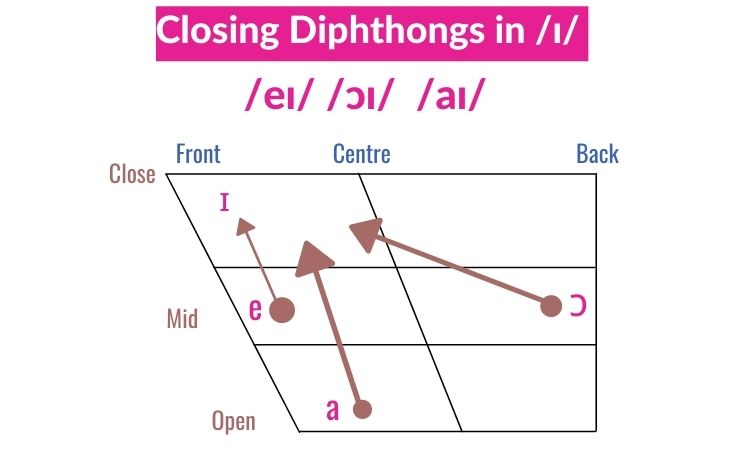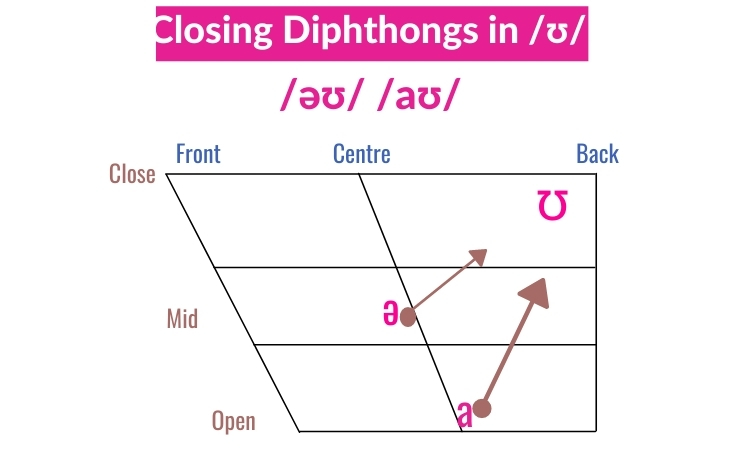Master the Pronunciation Theory & Practice and Become Comfortable Teaching it!

DIPHTHONGS
Diphthong
-> a type of vowel sound that is made up of a combination of 2 single vowel sounds.
-> a glide (or movement of the tongue, lips, and jaw) from one pure vowel sound(single vowel/monophthong)to another.
-> the first sound in each phoneme is longer and louder than the second in English.
Example:
– in the word house,/haʊs/ in the diphthong /aʊ/ we can hear that the /a/ part of the sound is longer than the final /ʊ/.
*If you try making the /ʊ/ part longer, you will hear the difference.
There are 8 Diphthongs in English and they are grouped into:
-> Centering Diphthongs /ɪə/, / ʊə/, /eə/
*end with a glide towards / ə/ – a center vowel discusses in details HERE
-> Closing Diphthongs /e ɪ/, /ɔɪ/, /aɪ /,/əʊ/, /aʊ/ *end with a glide towards /ɪ/ or towards /ʊ/
– We have discussed Close Vowels HERE
!!!Important Note
Diphthongs are perceived as one sound and should be treated as such!
Centering Diphthongs /ɪə/ / ʊə/ /eə/

/ɪə/

The glide begins in the position for /ɪ/, moving down and back towards / ə/.
The lips are neutral, but with a small movement from spread to open.
Common Words including the diphthong /ɪə/
*Magic e OR Silent final e
A split vowel digraph, commonly known as a magic e (/mæʤɪk i:/) is a short version of the sentence “silent final emakes the vowel say its name”. This means that in face the a sounds A; in delete the middle e sounds E; in price the isounds I; in home the o sounds O; in cute the usounds U. (See more details HERE.
Homophones – words that have the same pronunciation but different spellings.
Word Meanings – in case you might need them
* beer
an alcoholic drink made from grain and hops (= a type of plant):
He asked for a pint of beer.
This beer is brewed in Mexico.
* bier
These include the placement of an effigy atop a bier and sarcophagus, framed by weighty pillars and a triumphal arch.
The chief mourner walks ahead of the bier, taking fire in a porcelain pot.
* peer (noun)
a person who is the same age or has the same social position or the same abilities as other people in a group:
Do you think it’s true that teenage girls are less self-confident than their male peers?
He wasn’t a great scholar, but as a teacher he had few peers (= not as many people had the same ability as him).
* pier (verb)
to look carefully or with difficulty:
When no one answered the door, she peered through the window to see if anyone was there.
The driver was peering into the distance trying to read the road sign.
/ɪə/Sound difficulties for:
Arabic, Chinese, French, German, Greek, Indian Languages, Italian, Japanese, Portuguese, Russian, Scandinavian Languages, Spanish and Turkish.
Check the Phonology of your own first Language of your Students’ first Language (L1) on Wikipedia.
See what English sounds don’t exist in your/your Students L1. Proactively anticipate possible difficulties.
Here is the Phonology of my L1. (Ro)
Here is the Phonology of my Students’ L1. (Tr)
Which is Yours?
(if you are not a native English speaker, of course! 🙂 )
Which one is/are your students’?
/ʊə/

The glide begins in the position for /ʊ/, moving forwards and down towards /ə/.
The lips are loosely rounded, becoming neutrally spread.
Quite a RARE Diphthong!
Many speakers replace it with /:ɔ/
In Received Pronunciation, the IPA phonetic symbol /ʊə/corresponds to the diphthong sound in words like “cure” /kjʊər/and “tour” /tʊər/.
Currently, in Received Pronunciation this phoneme is disappearing, in favour of /ɔː/, in the so-called CURE-FORCE merger (also called pour-poor merger).[1] For example “tour” is pronounced either /tʊər/ or /tɔːr/. “Sure” can be pronounced either /ʃʊər/ or /ʃɔːr/.
In General American, on the other hand, /ʊər/ and /ʊr/ can be pronounced [ʊər] at the end of the syllable or before a consonant[2] or [ʊr] before a vowel.[3] Since the difference is predictable it can be said that General American doesn’t have an /ʊə/ phoneme. This should be called “CURE pronounced as FOOT”or (less precisely) “the CURE-FOOT merger” but we could find only one reference, as a comment in a blog.[4] See IPA phoneme /ʊ/.
In the United States a few words with /ʊər/ can be pronounced [ɜːr]. This is called the CURE-NURSE merger (also called cure-fir merger).[5]See IPA phoneme /ɜː/ and the Advanced material section.
In Received Pronunciation /ʊər/ and /ɔːr/ are pronounced [ʊə] and [ɔː] unless they are followed by a vowel, i.e. the “r” is normally silent unless it is followed by a vowel.
In General American the “r” is always pronounced.
There are places in the United Kingdom where the “r” is pronounced, and places in North America where it is not pronounced.
Words including the sound /ʊə/
/ʊə/Sound difficulties for:
Arabic, Chinese, French, German, Greek, Indian Languages, Italian, Japanese, Portuguese, Russian, Scandinavian Languages, Spanish and Turkish.
DILEMMA
Should we teach students a pronunciation that is falling out of use?
The words that still have [ʊə] in Received Pronunciation are very few.
When teaching General American the /ʊ/ pronunciation should be taught: cure as [ˈkjʊər] and curable as [ˈkjʊrəbəl].
/eə/

The glide begins in the position for /e/, moving back towards / ə/.
The lips remain neutrally open.
Words including the sound /eə/
Closing Diphthongs ending in /ı/ ( /e ɪ/, /ɔɪ/, /aɪ /)

/eı/

The glide begins in the position for /e/, moving up and slightly back towards /ı/.
The lips are spread.
Common Words including the diphthong /eɪ/
/ɔɪ/

The glide begins in the position for / ɔ/, moving up and forward towards /ı/.
The lips start open and rounded and change to neutral.
Common Words including the diphthong /ɔɪ/
/aɪ/

The glide begins in an open position, between front and centre, moving up, slightly forward towards /ı/.
The lips move from neutral to loosely spread.
Common Words including the diphthong /aɪ/
Closing Diphthongs ending in /ʊ/ (/əʊ/, /aʊ/ )

/əʊ/
The glide begins in the position for /ə/ moving up and back towards /ʊ/.
The lips are neutral but change to loosely rounded.

Common Words including the diphthong /əʊ/
/aʊ/

The glide begins in a position quite similar to /ɑː/ moving up towards /ʊ/.
The lips start neutral, with a movement to loosely rounded.
The glide is not always completed , as the movement involved is extensive.







This Post Has 7 Comments
Great content! Keep up the good work!
Thank you so much for the kind feedback and support!
Thanks for finally writing about > Diphthongs – Teaching Pronunciation with Confidence
& Love – Marina Carmen < Liked it!
I love it . Was really helpful especially with the massive diagrammatic representations of the sounds. Thanks
So happy it helped. Thank you for your feedback.
Wonderful material! Thank you! (correct a mistake in the slide of centring diphthongs. It says /eɪ/ instead of /eə/).
Thank you very much for the constructive feedback